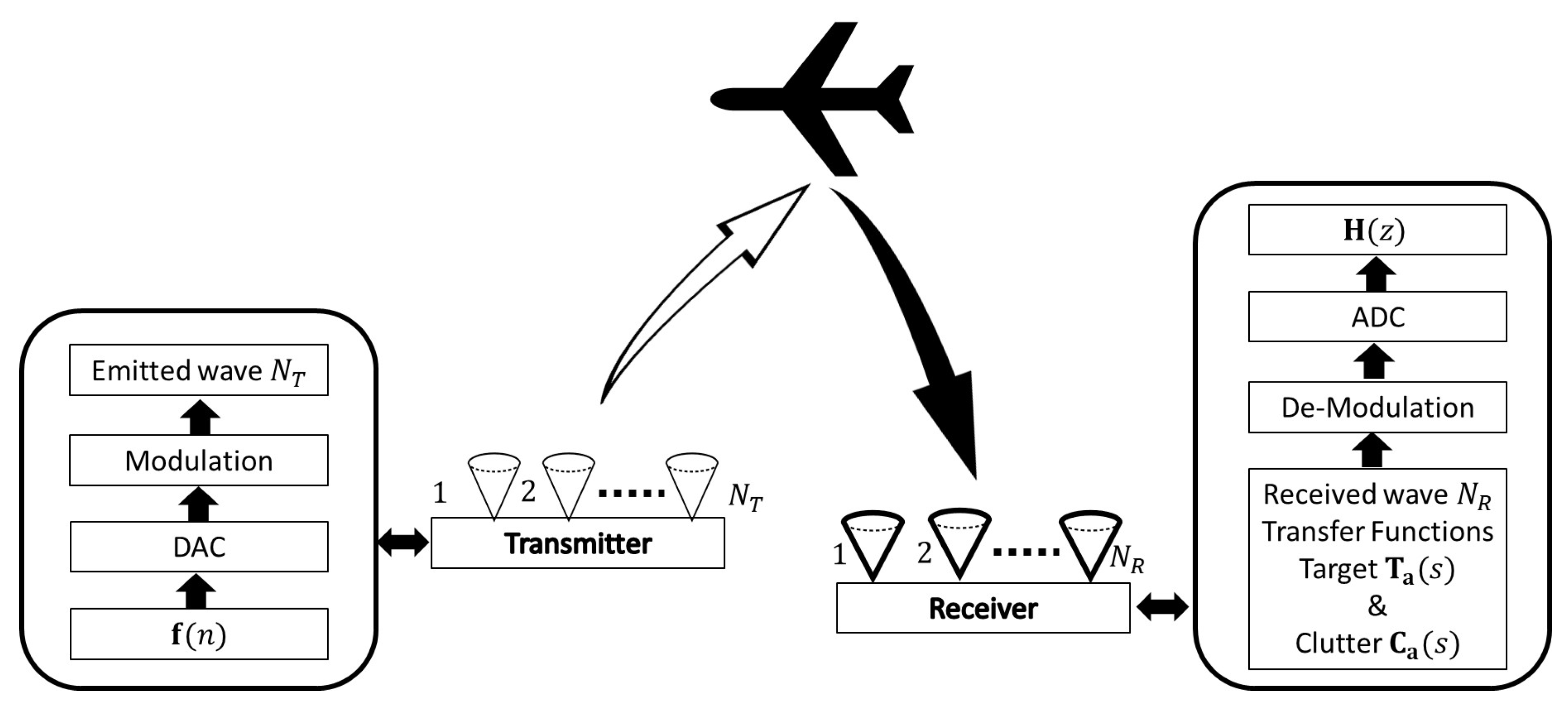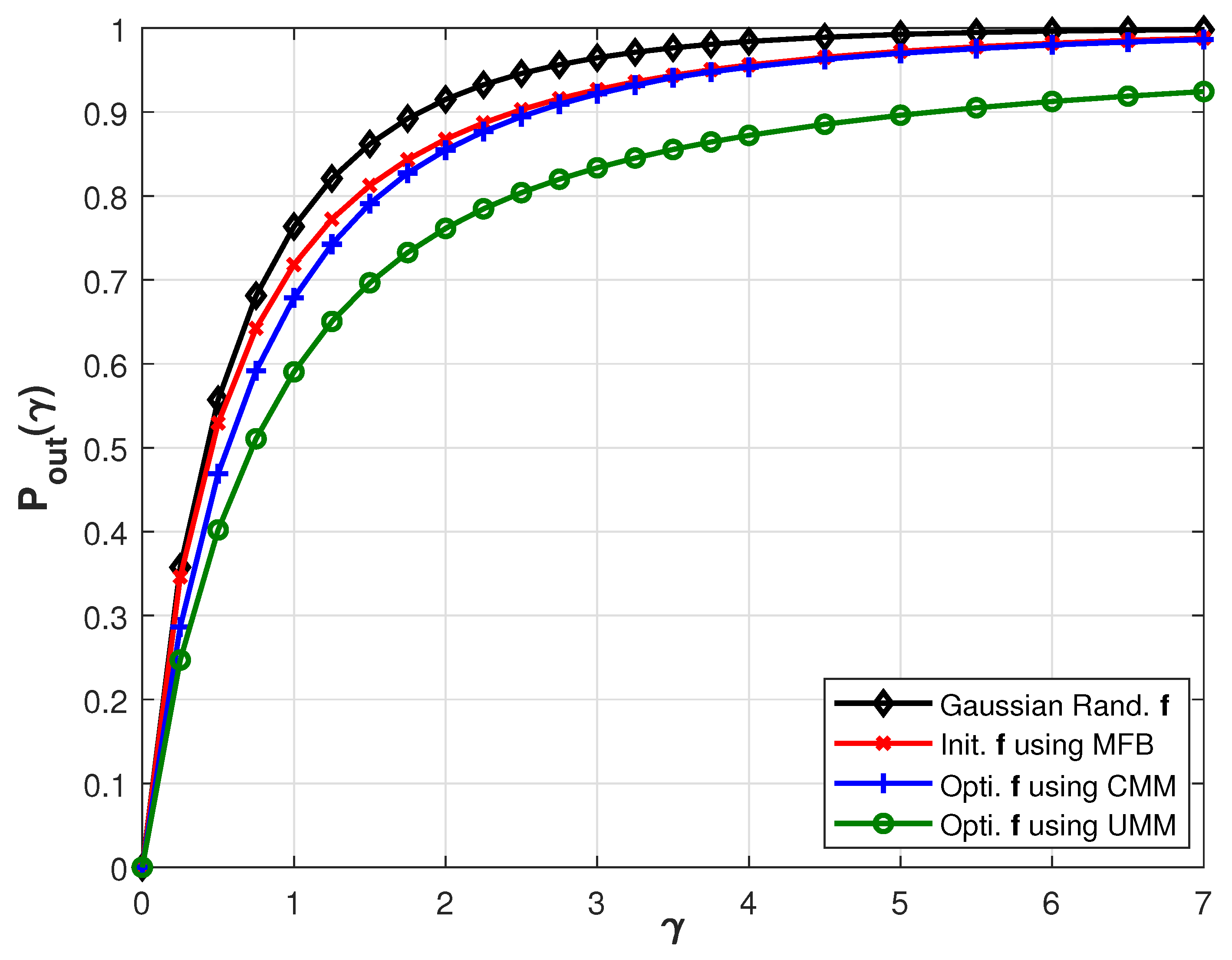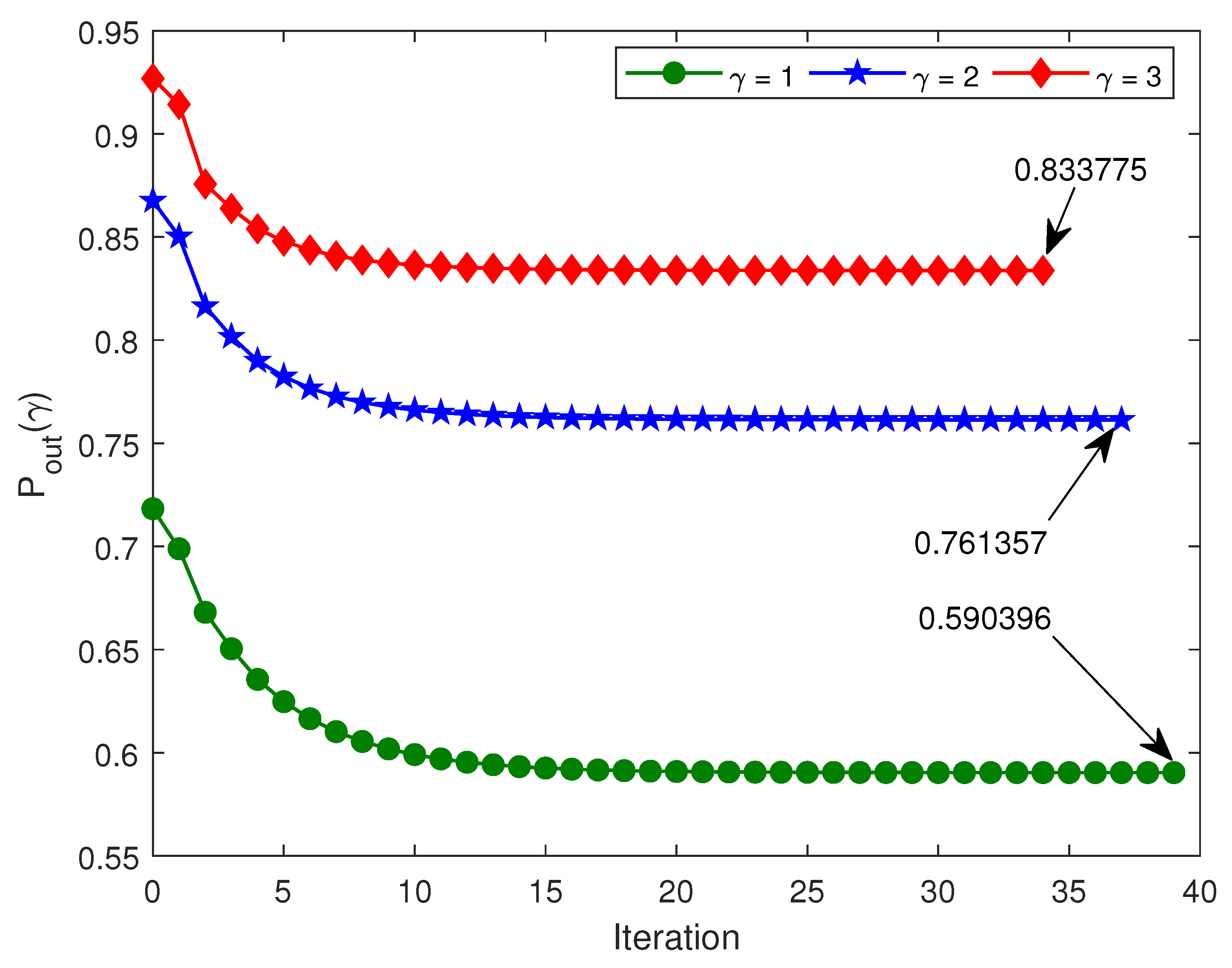Statistical Method Based Waveform Optimization in Collocated MIMO Radar Systems
Abstract
1. Introduction
2. System Model
3. Characterization of Outage Probability
4. Algorithms for Waveform Optimization
4.1. Closed-Form Solution of Transceiver Waveform
4.2. Heuristic Solution of Transceiver Waveform
| Algorithm 1 Build of Heuristic Search enabled Waveform Design |
|
5. Simulation Results and Discussions
5.1. Validation of Closed-Form Expressions
- Validation of the outage probability expression in (21) is showcased using Figure 2a. Therein, the values of and are obtained using the match filter bound. We increase the order of and from single-input single-output (SISO) cases to MIMO cases of 2 and 8. It is observed that a great degree of gain is achieved by increasing the antenna order of transceiver units, e.g., there is a 16.7% reduction in outage probability by moving from SISO to MIMO case by setting antenna order of 8 at . From the validation prospective, it is observed that a perfect degree of match exits across the range for all the considered antenna diversity orders;
- Validation of clutter signal PDF, i.e., in (3) is presented using Figure 2b. The aforementioned network configurations are considered herein as well. Due to the large values at low , a log scale axis is used. Again, a perfect match is observed between the analytical and closed-form expression;
- Validation of (21) by altering the transmit and receive filter order is demonstrated using Figure 3. Herein, we consider the case . Initially, we consider a single order filter at transmitter and receiver ends. There is a marked decrease of about 10% in the outage probability if the filter order of 2 is used as compared to 1 at . Furthermore, increasing the filter order further to 4 results only in a marginal change. Hence, in the remainder of the work, we consider a filter order of 2. Again, the Monte Carlo simulation ascertains the theoretical results across the range.
5.2. Minimization of
- Using Figure 4, we reflect on the performance while selecting a specific . Initially, we select using random complex Gaussian vector and normalize it to have power 1. Next, we employ a match filter bound and achieve local solutions of and also link it to obtain . This solutions shows consistent improvement across the gamma range and it reflects on the effectiveness of such a solution over a random selection of and . We set the local solution of , referred in Figure 4 as, `Init. using MFB’, as an initialization vector and perform CMM and UMM optimization using Algorithm 1. While the improvement is for both methods, the later, i.e., unconstrained approach finds excellent solutions across the range. Hence, in the forthcoming analysis, only UMM is considered while CMM shall have similar results;
- Using Figure 5, we indicate the convergence of Algorithm 1 at three different values of , i.e., at 1, 2, and 3 respectively. The plot shows that the convergence is achieved at the 39th, 37th, and 34th iteration, having terminal values of 0.590396, 0.761357, and 0.833775, for 1, 2, and 3 respectively. Hence, a faster convergence at higher values of threshold is observed. Note that the convergence is based on the objective function (outage probability), which is non-decreasing in a viable direction to within the the optimality tolerance threshold set as ;
- Using Figure 6, we demonstrate the time complexity for three sub-routines of Algorithm 1, namely, interior-point, sequential quadratic programming, and active-set approach. It is observed that the convergence of each of the three schemes is exactly the same and hence they find identical solutions; however, the time taken for each approach is different, hence the need for this analysis. The processor considered for this task is Intel(R) Core(TM) m7-6Y75 CPU 1.20 GHz 1.50 GHz with 16 GB RAM. Figure 6a is the scatter plot of the three sub-routines and it is observed that the `active-set’ method is finding solutions faster compared to its counterparts. The marked difference is especially notable at high threshold values where `active-set’ method is consuming just 0.05 s as compared with 0.6 s required for other methods. Figure 6b shows the box plot for the three sub-routines indicating the mean value and standard deviation with respect to time in seconds. Again, the `active-set’ method fairs better.
6. Conclusions
Author Contributions
Funding
Data Availability Statement
Conflicts of Interest
References
- Li, J.; Stoica, P. MIMO radar with colocated antennas. IEEE Signal Process. Mag. 2007, 24, 106–114. [Google Scholar] [CrossRef]
- Yi, W.; Zhou, T.; Xie, M.; Ai, Y.; Blum, R.S. Suboptimum Low Complexity Joint Multi-target Detection and Localization for Noncoherent MIMO Radar with Widely Separated Antennas. arXiv 2017, arXiv:1701.01532. [Google Scholar]
- Fishler, E.; Haimovich, A.; Blum, R.S.; Cimini, L.J.; Chizhik, D.; Valenzuela, R.A. Spatial diversity in radars—Models and detection performance. IEEE Trans. Signal Process. 2006, 54, 823–838. [Google Scholar] [CrossRef]
- Zheng, G.; Song, Y. Signal model and method for joint angle and range estimation of low-elevation target in meter-wave FDA-MIMO radar. IEEE Commun. Lett. 2021, 26, 449–453. [Google Scholar] [CrossRef]
- Li, J.; Stoica, P. MIMO Radar—Diversity Means Superiority; Wiley Online Library: Hoboken, NJ, USA, 2009. [Google Scholar]
- Lipor, J.; Ahmed, S.; Alouini, M.S. Fourier-based transmit beampattern design using MIMO radar. IEEE Trans. Signal Process. 2014, 62, 2226–2235. [Google Scholar] [CrossRef]
- Lipor, J.; Ahmed, S.; Alouini, M.S. Closed form fourier-based transmit beamforming for MIMO radar. In Proceedings of the 2014 IEEE International Conference on Acoustics, Speech and Signal Processing (ICASSP), Florence, Italy, 4–9 May 2014; IEEE: Piscataway, NJ, USA, 2014; pp. 5272–5276. [Google Scholar]
- Ahmed, S.; Thompson, J.S.; Petillot, Y.R.; Mulgrew, B. Unconstrained synthesis of covariance matrix for MIMO radar transmit beampattern. IEEE Trans. Signal Process. 2011, 59, 3837–3849. [Google Scholar] [CrossRef]
- He, H.; Stoica, P.; Li, J. Designing unimodular sequence sets with good correlations—Including an application to MIMO radar. IEEE Trans. Signal Process. 2009, 57, 4391–4405. [Google Scholar] [CrossRef]
- He, H.; Li, J.; Stoica, P. Waveform Design for Active Sensing Systems: A Computational Approach; Cambridge University Press: Cambridge, UK, 2012. [Google Scholar]
- Song, J.; Babu, P.; Palomar, D.P. Sequence set design with good correlation properties via majorization-minimization. IEEE Trans. Signal Process. 2016, 64, 2866–2879. [Google Scholar] [CrossRef]
- Stoica, P.; Li, J.; Xie, Y. On probing signal design for MIMO radar. IEEE Trans. Signal Process. 2007, 55, 4151–4161. [Google Scholar] [CrossRef]
- Fuhrmann, D.R.; San Antonio, G. Transmit beamforming for MIMO radar systems using signal cross-correlation. IEEE Trans. Aerosp. Electron. Syst. 2008, 44, 171–186. [Google Scholar] [CrossRef]
- Ahmed, S.; Thompson, J.S.; Petillot, Y.R.; Mulgrew, B. Finite alphabet constant-envelope waveform design for MIMO radar. IEEE Trans. Signal Process. 2011, 59, 5326–5337. [Google Scholar] [CrossRef]
- Hassanien, A.; Vorobyov, S.A. Transmit energy focusing for DOA estimation in MIMO radar with colocated antennas. IEEE Trans. Signal Process. 2011, 59, 2669–2682. [Google Scholar] [CrossRef]
- Ahmed, S.; Alouini, M.S. MIMO Radar Transmit Beampattern Design without Synthesising the Covariance Matrix. IEEE Trans. Signal Process. 2014, 62, 2278–2289. [Google Scholar] [CrossRef]
- Aubry, A.; De Maio, A.; Huang, Y. MIMO radar beampattern design via PSL/ISL optimization. IEEE Trans. Signal Process. 2016, 64, 3955–3967. [Google Scholar] [CrossRef]
- Chen, C.Y.; Vaidyanathan, P. MIMO radar waveform optimization with prior information of the extended target and clutter. IEEE Trans. Signal Process. 2009, 57, 3533–3544. [Google Scholar] [CrossRef]
- Karbasi, S.M.; Aubry, A.; Carotenuto, V.; Naghsh, M.M.; Bastani, M.H. Knowledge-based design of space–time transmit code and receive filter for a multiple-input–multiple-output radar in signal-dependent interference. IET Radar Sonar Navig. 2015, 9, 1124–1135. [Google Scholar] [CrossRef]
- Tang, B.; Li, J.; Zhang, Y.; Tang, J. Design of MIMO radar waveform covariance matrix for clutter and jamming suppression based on space time adaptive processing. Signal Process. 2016, 121, 60–69. [Google Scholar] [CrossRef]
- Tang, B.; Tang, J. Joint design of transmit waveforms and receive filters for MIMO radar space-time adaptive processing. IEEE Trans. Signal Process. 2016, 64, 4707–4722. [Google Scholar] [CrossRef]
- Davoli, A.; Guerzoni, G.; Vitetta, G.M. Machine learning and deep learning techniques for colocated MIMO radars: A tutorial overview. IEEE Access 2021, 9, 33704–33755. [Google Scholar] [CrossRef]
- Tang, Y.; Ma, X.; Sheng, W.; Han, Y. Transmit waveform optimization for spatial-frequency diversity MIMO radar in the presence of clutter. Int. J. Antennas Propag. 2014, 2014, 510569. [Google Scholar] [CrossRef]
- Li, Y.; Zheng, N.; Zhang, Y.; Li, H.; Hu, H. MIMO radar waveform design with similarity constraint in the presence of interference. In Proceedings of the 2017 IEEE 3rd Information Technology and Mechatronics Engineering Conference (ITOEC), Chongqing, China, 3–5 October 2017; IEEE: Piscataway, NJ, USA, 2017; pp. 18–22. [Google Scholar]
- Zivkovic, Z. Radar System. US Patent 15,439,003, 31 August 2017. [Google Scholar]
- Ren, C.L.; Pi, W.C.; Zhou, J.M.; Chen, N. MIMO | A Continuous Phase of the Optimal MIMO Radar Waveform Design Method. CN Patent CN110082731A, 2 August 2017. [Google Scholar]
- Chen, C.Y. Signal Processing Algorithms for MIMO Radar. Ph.D. Thesis, California Institute of Technology, Pasadena, CA, USA, 2009. [Google Scholar]
- Wu, L.; Babu, P.; Palomar, D.P. Transmit Waveform/Receive Filter Design for MIMO Radar with Multiple Waveform Constraints. IEEE Trans. Signal Process. 2018, 66, 1526–1540. [Google Scholar] [CrossRef]
- Wu, L.; Babu, P.; Palomar, D.P. A fast algorithm for joint design of transmit waveforms and receive filters. In Proceedings of the 2017 IEEE 18th International Workshop on Signal Processing Advances in Wireless Communications (SPAWC), Sapporo, Japan, 3–6 July 2017; IEEE: Piscataway, NJ, USA, 2017; pp. 1–5. [Google Scholar]
- Al-Naffouri, T.Y.; Moinuddin, M.; Ajeeb, N.; Hassibi, B.; Moustakas, A.L. On the distribution of indefinite quadratic forms in Gaussian random variables. IEEE Trans. Commun. 2016, 64, 153–165. [Google Scholar] [CrossRef]
- Hassan, A.K.; Moinuddin, M.; Al-Saggaf, U.M.; Aldayel, O.; Davidson, T.N.; Al-Naffouri, T.Y. Performance Analysis and Joint Statistical Beamformer Design for Multi-User MIMO Systems. IEEE Commun. Lett. 2020, 24, 2152–2156. [Google Scholar] [CrossRef]
- Moinuddin, M.; Hassan, A.K.; Al-Saggaf, U.M. Performance Analysis of Multi-Cell Association in Downlink MU-MIMO System with Arbitrary Beamforming. Mathematics 2022, 10, 2611. [Google Scholar] [CrossRef]
- Al-Saggaf, U.M.; Moinuddin, M.; Alshoubaki, M.K.; Hassan, A.K. Method of Processing Waveforms at a Multiple-Input-Multiple-Output (MIMO) Radar for an Unknown Target. US Patent 10,895,635, 19 January 2021. [Google Scholar]
- Zhu, W.; Tang, J. Robust design of transmit waveform and receive filter for colocated MIMO radar. IEEE Signal Process. Lett. 2015, 22, 2112–2116. [Google Scholar] [CrossRef]
- Naghsh, M.M.; Modarres-Hashemi, M.; Kerahroodi, M.A.; Alian, E.H.M. An information theoretic approach to robust constrained code design for MIMO radars. IEEE Trans. Signal Process. 2017, 65, 3647–3661. [Google Scholar] [CrossRef]
- Azarang, M.; Derakhtian, M.; Sheikhi, A. Signal design based on post-detection SINR for MIMO radar in the presence of signal-dependent interference. IET Radar Sonar Navig. 2022, 16, 76–90. [Google Scholar] [CrossRef]
- Kong, L.; Li, N.; Cui, G.; Yang, H.; Liu, Q.H. Adaptive Bayesian detection for multiple-input multiple-output radar in compound-Gaussian clutter with random texture. IET Radar Sonar Navig. 2016, 10, 689–698. [Google Scholar] [CrossRef]
- Liu, J.; Han, J.; Zhang, Z.J.; Li, J. Bayesian detection for MIMO radar in Gaussian clutter. IEEE Trans. Signal Process. 2018, 66, 6549–6559. [Google Scholar] [CrossRef]
- Gradshteyn, I.S.; Ryzhik, I.M. Table of Integrals, Series, and Products; Academic Press: Cambridge, MA, USA, 2014. [Google Scholar]
- Horn, R.A.; Johnson, C.R. Matrix Analysis; Cambridge University Press: Cambridge, UK, 1990. [Google Scholar]






| Paper | SINR Formulation | Outage Probability | Optimization Approach |
|---|---|---|---|
| [18] | ✓ | × | Chen & Vaidyanathan iterative method |
| [22] | ✓ | × | Machine learning & deep learning techniques |
| [34] | ✓ | × | Cyclic optimization algorithm |
| [35] | ✓{Indirectly} | × | Minorization- maximization based method |
| [36] | ✓ | × | Rao-based detector |
| Proposed | ✓ | ✓ | Interior-Point based approach |
Disclaimer/Publisher’s Note: The statements, opinions and data contained in all publications are solely those of the individual author(s) and contributor(s) and not of MDPI and/or the editor(s). MDPI and/or the editor(s) disclaim responsibility for any injury to people or property resulting from any ideas, methods, instructions or products referred to in the content. |
© 2023 by the authors. Licensee MDPI, Basel, Switzerland. This article is an open access article distributed under the terms and conditions of the Creative Commons Attribution (CC BY) license (https://creativecommons.org/licenses/by/4.0/).
Share and Cite
Hassan, A.K.; Al-Saggaf, U.M.; Moinuddin, M.; Alshoubaki, M.K. Statistical Method Based Waveform Optimization in Collocated MIMO Radar Systems. Mathematics 2023, 11, 680. https://doi.org/10.3390/math11030680
Hassan AK, Al-Saggaf UM, Moinuddin M, Alshoubaki MK. Statistical Method Based Waveform Optimization in Collocated MIMO Radar Systems. Mathematics. 2023; 11(3):680. https://doi.org/10.3390/math11030680
Chicago/Turabian StyleHassan, Ahmad Kamal, Ubaid M. Al-Saggaf, Muhammad Moinuddin, and Mohamed K. Alshoubaki. 2023. "Statistical Method Based Waveform Optimization in Collocated MIMO Radar Systems" Mathematics 11, no. 3: 680. https://doi.org/10.3390/math11030680
APA StyleHassan, A. K., Al-Saggaf, U. M., Moinuddin, M., & Alshoubaki, M. K. (2023). Statistical Method Based Waveform Optimization in Collocated MIMO Radar Systems. Mathematics, 11(3), 680. https://doi.org/10.3390/math11030680






